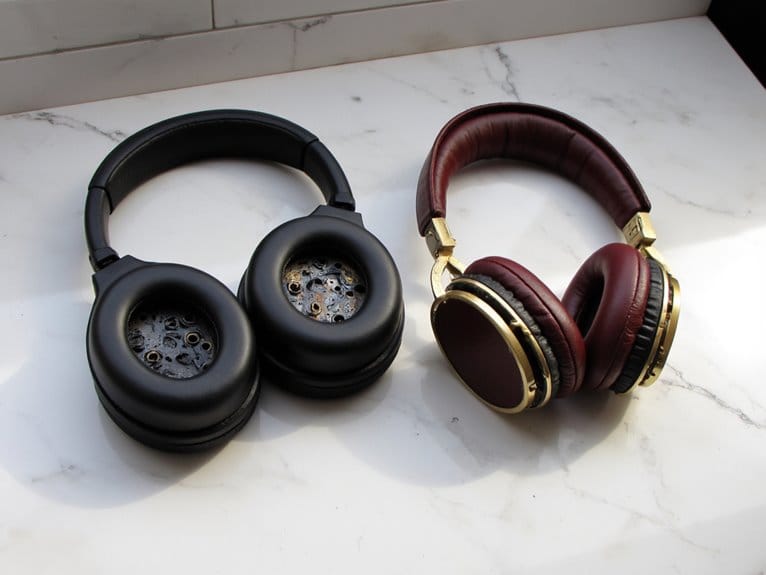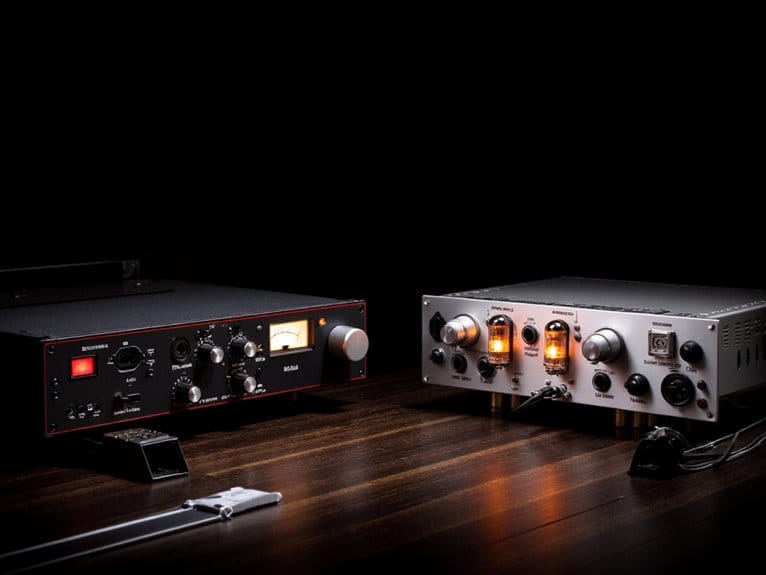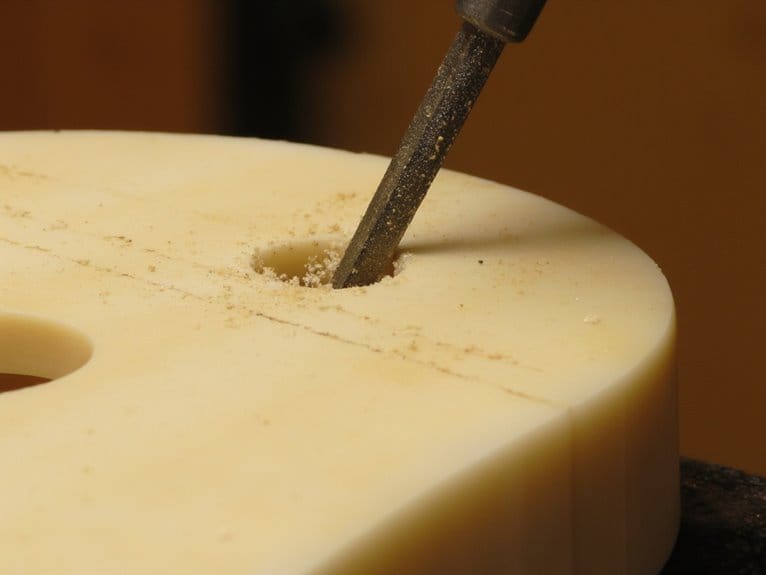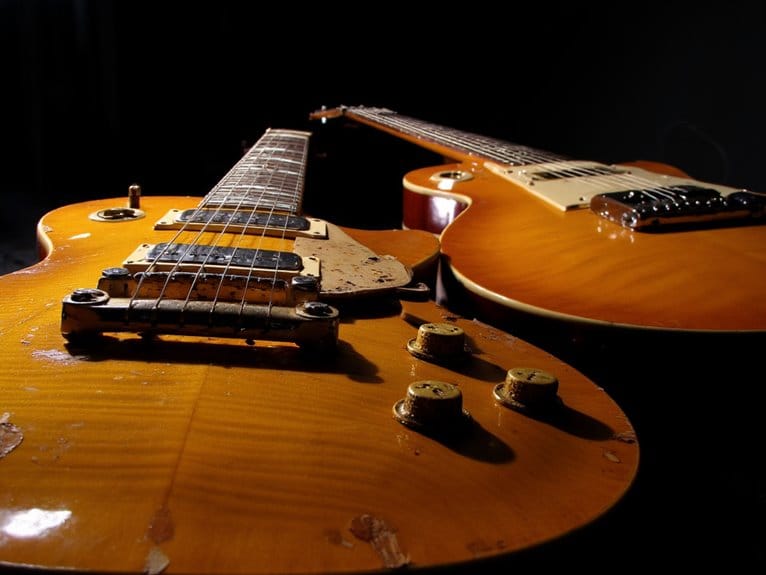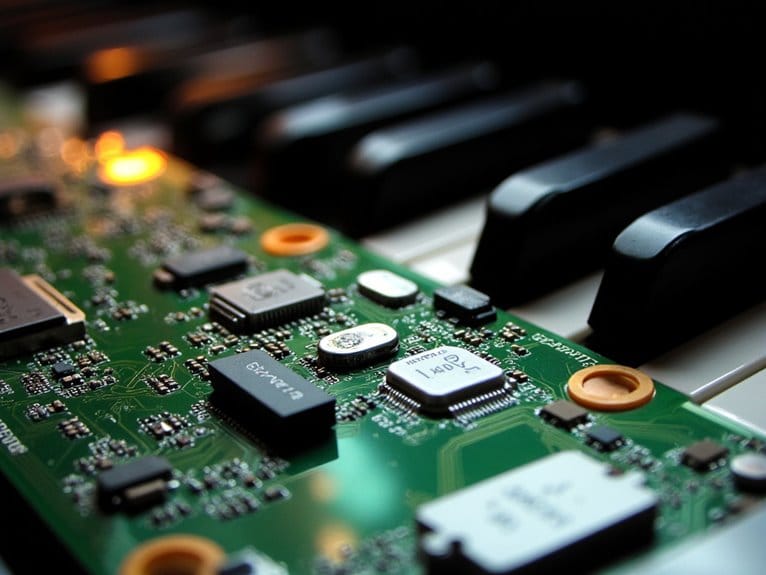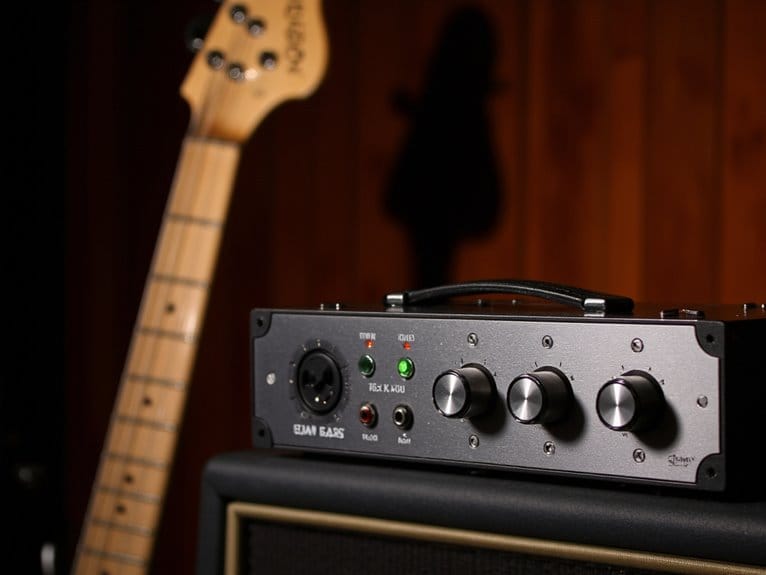Flat Response Vs Colored Headphones: Which Is Better?
You’ll want flat response headphones if you’re mixing audio or need accurate sound reproduction, as they deliver equal emphasis across all frequencies without coloring the original recording. However, if you’re gaming, enjoying music casually, or prefer enhanced bass and treble, colored headphones provide a more engaging experience by boosting specific frequency ranges. Your choice depends on whether you prioritize technical accuracy or entertaining sound enhancement, though your unique ear anatomy and listening environment will ultimately influence performance regardless of which type you select.
We are supported by our audience. When you purchase through links on our site, we may earn an affiliate commission, at no extra cost for you. Learn more.
Notable Insights
- Flat response headphones deliver accurate, uncolored sound reproduction essential for audio production, mixing, and critical listening applications.
- Colored headphones enhance specific frequencies like bass or treble, creating more engaging experiences for music, gaming, and entertainment.
- Professional audio work requires flat response for mix translation accuracy, while casual listening often benefits from colored sound.
- Individual ear anatomy and listening environments significantly affect which headphone type will sound better to each person.
- Neither is universally “better” – the choice depends on your primary use case, personal preferences, and listening context.
Understanding Flat Response and Colored Headphone Technologies
When you’re diving into the world of headphones, understanding the fundamental difference between flat response and colored sound signatures becomes essential for making informed purchasing decisions.
Flat response headphones aim to deliver equal emphasis across all frequency ranges, providing accurate reproduction of audio as originally recorded, which makes them invaluable for audio production and sound design work. However, truly flat headphones do not actually exist in practice, and even when designed to be flat, they often don’t sound flat to listeners.
Flat response headphones provide accurate audio reproduction across all frequencies, making them essential tools for professional audio production and sound design applications.
Colored headphones, however, feature intentionally modified frequency curves that boost or reduce specific ranges, creating tailored experiences that match different listening habits and user experiences. Manufacturers have developed proprietary target curves to better align with listener preferences rather than pursuing traditional flat response designs.
These headphone types serve distinct purposes, with flat models prioritizing neutrality for audio engineering applications, while colored variants leverage acoustic properties and tech advancements to enhance particular frequencies for entertainment-focused consumers. Professional flat response models often incorporate 40mm drivers as the industry standard for achieving accurate sound reproduction. Professional models like the Sony MDR7506 offer flat frequency response specifically designed for accurate sound reproduction in studio environments.
Sound Accuracy and Audio Fidelity Comparison
Building on these technological foundations, I’ve found that the real battle between flat response and colored headphones comes down to one fundamental question: how accurately do they reproduce what you’re supposed to hear?
| Aspect | Flat Response | Colored Response |
|---|---|---|
| Sound Fidelity | Maintains original recording integrity | Enhances specific frequencies for preference |
| Tonal Balance | Neutral across all frequencies | Emphasizes bass, mids, or treble |
| Distortion Levels | Minimized for accuracy | May increase due to frequency boosting |
| Mix Translation | Excellent for professional use | Variable depending on coloration |
| Detail Retrieval | Superior clarity and nuance | Potential masking of subtle elements |
When you’re evaluating headphones for accuracy, flat response models consistently deliver superior sound fidelity by preserving the original recording’s intended tonal balance, while colored alternatives prioritize subjective enhancement over faithful reproduction. Professional models like the Sony MDR7506 are known for their flat frequency curves, making them ideal for critical monitoring applications. Professional-grade headphones with extended frequency response ranges up to 40 kHz provide enhanced dynamic richness that can help distinguish between truly flat and subtly colored sound signatures.
Professional Vs Consumer Use Cases and Applications
After years of testing headphones across different environments, I’ve discovered that your intended use case fundamentally determines whether you’ll benefit more from flat response or colored sound signatures.
If you’re involved in audio production, mixing, or broadcasting, flat response headphones deliver the neutral accuracy essential for professional work, directly impacting worker productivity through precise sound reproduction that reveals audio flaws requiring correction.
However, if you’re primarily consuming music, gaming, or streaming content, colored headphones align better with typical audio preferences, offering enhanced bass and treble that make entertainment more engaging.
For entertainment-focused listening, colored headphones with boosted bass and treble deliver more engaging experiences than neutral alternatives.
The hybrid work environment has blurred these distinctions somewhat, as many professionals now need versatile headphones that handle both critical listening tasks and casual media consumption effectively.
Professional mixing headphones prioritize flat frequency response across the 20Hz-20kHz range to prevent coloration that could compromise how your mix translates across different playback systems.
Technical Challenges in Achieving Perfect Frequency Response
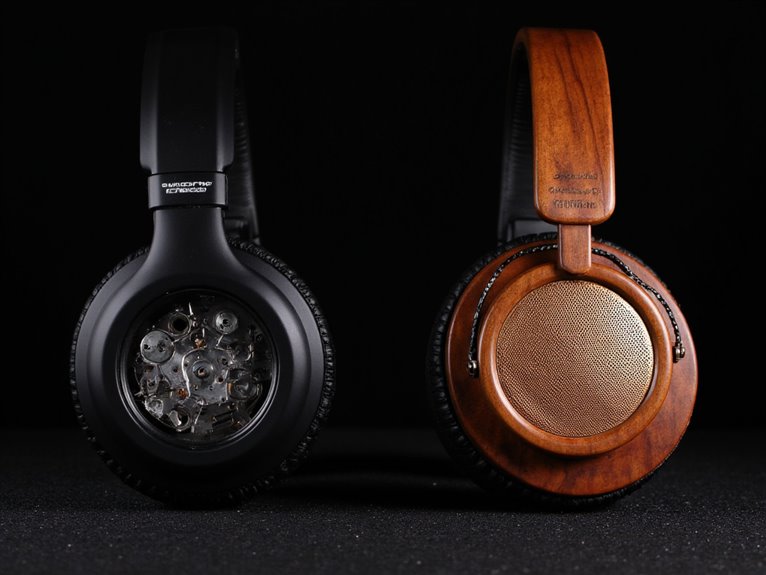
You’ve probably wondered why manufacturers can’t just create headphones with perfect flat response, but the reality is that achieving truly accurate frequency reproduction involves overcoming significant technical hurdles that go far beyond simply tuning drivers.
The physical limitations of headphone hardware, from driver materials and enclosure designs to acoustic coupling mechanisms, create inherent constraints that prevent manufacturers from easily achieving flat response across the entire audible spectrum.
Even more challenging, your unique ear anatomy, head shape, and the variations in measurement standards used by different companies mean that what sounds “flat” to you might sound completely different to someone else wearing the exact same headphones.
Hardware Design Limitations
When you plunge into the engineering reality behind headphone design, you’ll quickly discover that achieving a perfectly flat frequency response isn’t just challenging-it’s practically impossible due to fundamental physical constraints.
Driver limitations stem from material properties and mechanical behaviors that create inherent compromises. Dynamic drivers excel at certain frequencies while struggling with others, forcing manufacturers to choose between perfect bass extension or pristine treble clarity.
These engineering challenges manifest in three critical areas:
- Low-frequency reproduction demands larger diaphragms that compromise portability and comfort.
- Midrange shifts require complex crossover designs that introduce phase irregularities.
- High-frequency extension causes resonance peaks that necessitate careful damping.
Modern headphone design involves balancing these psychoacoustic factors with consumer expectations.
Even advanced equalization techniques can’t completely overcome fundamental driver physics, which explains why sound coloration often becomes a feature rather than a flaw, and why tuning preferences vary dramatically across manufacturers.
Individual Ear Anatomy
Beyond the mechanical constraints of driver design lies an even more fundamental challenge: your individual ear anatomy creates a unique acoustic fingerprint that makes achieving a truly universal flat frequency response nearly impossible.
Your ear canal variations in length, diameter, and curvature greatly influence how sound waves reflect and resonate, affecting the frequencies you actually hear versus what the headphone produces.
Meanwhile, your pinna shape determines how sound funnels into your ear canal, modifying perceived timbre and frequency emphasis in ways manufacturers can’t predict.
These anatomical differences mean the same headphone will sound distinctly different between listeners, explaining why your friend’s favorite “flat” headphones might sound bass-heavy or bright to you despite identical technical specifications.
Measurement Standard Variations
While individual ear anatomy creates one layer of complexity in achieving flat response, the technical measurement standards themselves introduce another significant hurdle that I’ve witnessed firsthand during my years evaluating headphones.
You’ll find that frequency response measurements vary dramatically between labs, even when testing identical headphones, because positioning and equipment differ substantially.
Here’s what makes standardized measurement standards so challenging:
- Placement inconsistencies – Over-ear headphones shift slightly during testing, creating measurement variations exceeding 3 dB.
- Equipment differences – Various Head and Torso Simulators produce conflicting results between manufacturers.
- Target curve disputes – Companies can’t agree whether flat response or preference-based curves represent accuracy.
I’ve seen identical headphones measure differently across facilities, making direct comparisons frustrating for consumers seeking truly neutral sound.
Listening Experience Factors Across Different Environments
Your headphones’ performance dramatically shifts depending on where you’re actually using them, and I’ve learned through years of testing that what sounds perfect in my quiet studio often falls flat when I’m commuting on a noisy train.
The acoustic environment you choose for listening fundamentally alters how you’ll perceive both flat and colored frequency responses, with studio settings favoring accuracy while mobile environments often demand the extra punch that colored headphones provide.
Whether you’re sitting stationary in your dedicated listening room or walking through bustling city streets, these environmental factors will determine which headphone tuning actually delivers the most satisfying experience for your specific use case.
Studio Vs Home Environments
When choosing between flat response and colored headphones, the environment where you’ll use them fundamentally shapes which approach serves you best.
Studio acoustics demand neutrality because you’re making critical decisions about audio quality, identifying distortions, and ensuring your work translates properly across different playback systems.
Meanwhile, home comfort prioritizes enjoyment over clinical accuracy, where colored signatures can actually enhance your listening pleasure.
The environmental differences create distinct needs:
- Studio environments require uncompromising accuracy to detect flaws and maintain professional standards
- Home settings benefit from warmer, more forgiving sound that reduces fatigue during extended listening
- Acoustic treatment varies dramatically, affecting how each headphone type performs in your specific space
I’ve found that understanding your primary listening environment eliminates much confusion about which headphone philosophy suits your actual needs.
Noisy Vs Quiet Settings
Background noise fundamentally alters how flat response and colored headphones perform, creating a dynamic where your environment’s sound levels determine which tuning philosophy delivers better results.
In noisy environments, flat response headphones struggle as subtle details become masked, while colored headphones with enhanced bass or treble can partially overcome ambient interference through frequency emphasis.
Your user behavior naturally adapts to these challenges-you’ll find yourself cranking volume dangerously high without proper noise cancellation, pushing levels beyond safe 85 dBA thresholds.
Device technology like active noise cancellation becomes essential here, reducing ambient sound by 20-40 dB and preserving both comfort levels and hearing health.
Quiet environments favor flat response headphones, where accurate reproduction shines without competing against background noise, allowing lower volume control settings that satisfy your listening needs safely.
Mobile Vs Stationary Listening
Movement patterns and listening environments create stark differences in how flat response versus colored headphones serve your audio needs, with mobile scenarios demanding entirely different compromises than stationary setups.
When you’re constantly moving, in ear convenience and wireless mobility become paramount, though compression effects and audio latency might compromise flat response accuracy.
Battery considerations further complicate mobile listening, as power-saving features can alter sound signatures. Meanwhile, stationary environments favor over ear fidelity with superior sound isolation and stationary comfort for extended sessions.
Your environment determines the practical winner:
- Noisy commutes demand colored sound to cut through ambient chaos
- Home listening rewards flat response accuracy without external interference
- Gym sessions prioritize secure fit over audiophile precision
Headphone ergonomics and mobile adaptability often override pure sound quality when you’re constantly on the move.
Frequently Asked Questions
Do Flat Response Headphones Cost More Than Colored Headphones?
When making a price comparison, you’ll typically find flat response headphones cost more than colored ones. They’re engineered for precise audio quality, requiring specialized components that drive up manufacturing costs compared to consumer-focused alternatives.
How Can I Test if My Headphones Have Flat Response?
You can test your headphones’ frequency response using online sweep tests at low volumes, checking for missing or emphasized frequencies. For accurate headphone calibration, compare results with professional measurement databases or use calibrated microphones for objective verification.
On a final note
You’ve got to choose what works for your ears and your wallet, because honestly, there’s no universal winner here. If you’re mixing tracks professionally, you’ll probably lean toward flat response for that clinical accuracy, but if you’re just jamming out to your favorite playlist, colored headphones might give you that extra punch you’re craving. Trust your listening habits over marketing hype.

